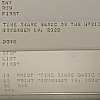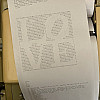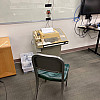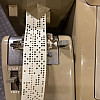BASIC
With a Teletype Model 33 ASR and an emulator, one can experience what computing was like for many before microcomputers.
Sharing Time
In the early 1960s, computer installations used batch processing on mainframe systems by scheduling jobs in a queue and running them one by one. The reason behind this practice was clear: there were relatively few computers available in industry, government, and academia, and computer time was a limited and valuable resource. The machines were to be used to the fullest extent possible. Computing was different from what we experience today, with our immediate access to processing power, multitasked applications, compilers, executables, input and output files, and other coding tools and resources.
The shift to "personal computing" -- immediate and direct access to a computer -- was deliberate and sometimes controversial. It first appeared in the form of time share systems and one of the earliest examples was the Dartmouth Time Share System (DTSS) in the mid-to-late 1960s. DTSS was an important development that broadened access to computers (see Finding LOVE).
Time sharing rapidly switched a computer processor between dozens (then hundreds) of users who worked on a machine interactively. Quick turnaround times for its users led to higher productivity despite dedicating more computer cycles to polling. Time sharing led to new computing communities and especially advanced burgeoning acts of creative coding. [1] Companies built time share services that could be accessed by modem, and one of the largest was General Electric's Information Services Department -- which would later evolve into the proto-online service GEnie. Early in the history of Apple Computer, Randy Wigginton used one time share service to develop AppleSoft BASIC -- a process that demonstrated its downside when their provider, Call Computer, inadvertently erased several user accounts and backup tapes, causing him to lose weeks worth of work with a looming deadline. [2]
By the 70s, Hewlett Packard, Digital Equipment Corporation, and other computer manufacturers, were selling computer systems that were adapted specifically for the time sharing market. Their minicomputers were relatively inexpensive machines that school districts and universities could purchase to establish campus or district-wide time sharing systems. These replicated many aspects of the pioneering Dartmouth system. Hewlett Packard's HP-2000 and DEC's PDP-11 minicomputer lines were popular choices. One example of a school district computer education program was Project DELTA ("Delaware’s Total Approach to computer knowledge"), which operated a time share service for the state of Delaware, including districts in its two rural southern counties. [3] Like DTSS, Project DELTA sought to engage students beyond only math and science classes and "...to make clear to teachers the difference between CAI [computer aided instruction] and computer knowledge." By 1975 about 50% of the high schools in the state of Delaware were affiliated with Project DELTA. Similarly, many students across the US, including Bill Gates and Paul Allen, had their first computer and programming experiences with time share services in schools. [4]
An emulated time share system
I was inspired to explore time share systems after reading Joy Lisi Rankin's book, A People's History of Computing in the United States [1], especially because these systems played an important role in the development of creative coding. Around the same time, a friend had dug out a few old rolls of paper punch tape from storage. These tapes held copies of programs that he and his friends had written in junior high school, around 1975, when the Philadelphia School District ran its own time share system and used it for instruction. It was an HP ACCESS BASIC system.
With a working Teletype Model 33 ASR, I had half of the typical time share user experience already on hand. The light duty Model 33 was a common terminal for time sharing because it was relatively inexpensive and it could connect to a distant computer facility with a modem (at 110 baud). In the late 60s and early 70s, the expanding Kiewit network at Dartmouth used teletypes and modems to provide service to high schools across New England and as far away as New Jersey.
Setting up an emulated HP ACCESS BASIC system is straightforward. The simh "History Simulator," an emulator for multiple historic computer systems, has an advanced HP-2000 simulator. [5] The emulator runs in two separate instances that replicate the function of the two HP-2000 processors of a real installation: one is dedicated to most of the system and user commands and the other directs the time sharing for up to 32 simultaneous users. I first started running the simulator on a Raspberry Pi model 1 A+. The single board computer ran well enough for the teletype console I/O, but I had problems using the paper tape reader.
HP ACCESS BASIC has two commands that made use of the teletype's paper tape reader and reperforator (tape punch): TAPE and PUNCH. (Each ACCESS BASIC command can be substituted with its first three characters, in this case, TAP and PUN.) The latter command is like LIST, the familiar BASIC command that generates a program listing, but PUN also adds a leader (and trailer) of NULL bytes, which help later when one loads the tape in the reader. So, the PUN command can be used to make a punch tape archive of a program. The TAPE command reads a punch tape in by issuing the control characters that start and stop the reader: CNTL-S (DC3 or XONx) and CNTL-Q (DC3 or XON). This software-side flow control should be familiar to terminal users when they needed to temporarily halt a scrolling display, a function that was actually borrowed from the older teletypes. In the HP ACCESS BASIC system, as a tape is read in, each program line ends with carriage return and line feed characters. The system temporarily pauses the tape reader while the line is processed, and then restarts the reader to read in the next line.
After some troubleshooting, I found that the Pi wasn't fast enough to use the tape reader. The TAPE command would start the reader, but it would become garbled after a line or two. It took some time to determine that all of the appropriate flow control signals were being transmitted back and forth. Running the emulator on a faster (but still about 10 year old) system under Debian solved the issues with the TAPE command. Headless operation on the remote server only required one small modification to the start.inc script, which starts the second simh instance:
! nohup stdbuf -i0 -o0 -e0 '%SIM_EXEC%' %1 %2 %3 %4 %5 &
I normally run the startup script hp2100 tab-auto.sim under screen, which can be detached for later monitoring. In all, the Pi was likely running with just enough lag that the flow control wasn't synchronizing properly.
Currently, the Model 33 Teletype connects to a local machine by a wifi232 modem. From there, I run ssh and log into the emulated system. The ssh session starts a telnet to the HP ACCESS emulation. If the machine was local, I could telnet directly to HP ACCESS, but my (cough, cough) service provider blocks many incoming ports. I've also had the Model 33 connected to the ttyAMA0 serial port of the Raspberry Pi (which can handle 110 baud) and used that to telnet or ssh into the emulation.
1973 UXP
The Teletype and remote HP ACCESS BASIC system replicate the user experience on time share systems in the 60s and 70s. It's slow and loud. It takes a long time to print a program, or even the file directory. (Hopefully the LIBRARY isn't too large.) Entering programs is error prone and fraught. It's amazing.
I used the emulated system to run programs that were shared widely during 70s: AMAZE, LOVE, and others, and also to write my own BASIC programs (see PUNW3 below). The HP ACCESS BASIC dialect differs substantially from microcomputer BASICs (the most widely distributed were the earliest products of Microsoft -- see Version1 on running the earliest version, Altair BASIC), but it's likely similar to its Dartmouth ancestor: there is only one statement per line; [6] the matrix calculations are significant and missing from any microcomputer dialect that I've used; and PRINT statements can be formatted using PRINT USING or IMAGE commands that resemble FORTRAN. The line numbers in BASIC were a design decision that made it possible for fast compilation times (BASIC was originally a compiled language). Compared to the practice of using indenting and other structural designators like brackets in modern languages, the uniform vertical and horizontal spacing of a BASIC program makes it significantly more difficult to read.
My time is tracked on the system. In the past, I would have been allocated a certain amount of time or billed for the time that I used. I'm wary of keeping myself logged on. Plus, the teleprinter is loud and heats up as it idles, waiting for input. Schools connected to time shared systems would typically have had one or two machines at most, [3] but some colleges and universities, including Dartmouth, had dozens of teletypes. It must have made quite a racket. How did anyone work through that electromechanical din?
The teletype speed is 10 characters per second. The punch program below is about 2700 characters. Each printout of the program takes four and a half minutes to generate. A punch tape archive of the program will always list the program, too. There's no way for the teletype to separate its punching and typing operations. Reading the program back in through the tape reader, though, it is possible to turn off the system echo with the command ECHO-OFF and suppress the printout. The tape reader chugs along in its staccato rhythm. Again, it takes four and a half minutes, after which normal operation is resumed with the command ECHO-ON.
Try HP ACCESS BASIC
Give HP ACCESS BASIC a test drive. Directions for logging on to an emulated service are here: HPBASIC.
In action
A video of the Teletype Model 33 ASR in action, reading in a ca. 1975 HP ACCESS BASIC tape.
ACCESS BASIC programs
PUNW3
This HP ACCESS BASIC program punches ASCII letters using the teletype (or other teleprinter) paper tape punch. The program starts and stops the tape using DC2 and DC4 control characters. The bit patterns of the punched letters are generated by a sequence of two to six ASCII characters.
Here's a sample run:
RUN PUNW3 ?HP BASIC @@@@_DD_@_EEB@@@@_UUN@^EE^@RUUI@_@NQQJ@@@@ DONE
Without a physical paper punch, the program output can be viewed using the BSD games ppt command:
$ ppt @@@@_DD_@_EEB@@@@_UUN@^EE^@RUUI@_@NQQJ@@@@ ___________ | o . | | o . | | o . | | o . | | o oo.ooo| | o .o | | o .o | | o oo.ooo| | o . | | o oo.ooo| | o .o o| | o .o o| | o . o | | o . | | o . | | o . | | o . | | o oo.ooo| | o o .o o| | o o .o o| | o o.oo | | o . | | o oo.oo | | o .o o| | o .o o| | o oo.oo | | o . | | o o . o | | o o .o o| | o o .o o| | o o. o| | o . | | o oo.ooo| | o . | | o o.oo | | o o . o| | o o . o| | o o. o | | o . | | o . | | o . | | o . | ___________ $
Below is the PUNW3 code listing. There are nine strings of 10 character bitmaps and one of five bitmaps for a total of 95 printable ASCII characters (between 0x20 and 0x7E). Two arrays (L and M) keep track of the number of letters for each character and the position relative to the concatenated character strings. The maximum string length in HP ACCESS BASIC is 72 characters and strings can be named with a letter or a letter and the number 0 or 1 for a total of 78 possible names. Some characters aren't accessible using an ASR-33 because the teletype uses ASCII-63; hence, there is no tilde, underscore, or vertical bar, for example.
LIST PUNW3 10 REM PUNCH A MESSAGE TO TAPE 20 REM LARGER LETTER VERSION 25 REM ALL ASCII LETTERS 30 REM E. FURST, DECEMBER 2022 40 DIM A0$[52],A1$[52],B0$[52],B1$[52],C0$[52] 50 DIM C1$[52],D0$[52],D1$[52],E0$[54],E1$[20] 70 DIM T$[72],S$[4],P$[6] 100 DIM L[95],M[95] 120 LET A0$="@@@W@C@C@J_J_J@R]WI@C[D[X@JUVHQ@C@NQ@QN@" 121 LET A1$="JD_DJ@DD_DD@PH@DDD@P@XDC@NQQN@Q_P@YUUR@QQUUJ@" 122 LET B0$="GD_D@WUUI@NUUH@AYEC@JUUJ@BUUN@J@PJ@DJQ@JJJ@" 123 LET B1$="QJD@AUEB@NQWUB@^EE^@_UUN@NQQJ@_QQN@_UUU@_EEE@NQUM@" 124 LET C0$="_DD_@_@HPPO@_DJQ@_PP@_BDB_@_BDH_@NQQN@_EEB@NQIV@" 125 LET C1$="_EMR@RUUI@A_A@OPPO@CLPLC@OPNPO@QJDJQ@AB\BA@YUS@_Q@" 126 LET D0$="CDX@Q_@BAB@PPP@AB@^EE^@_UUN@NQQJ@_QQN@_UUU@" 127 LET D1$="_EEE@NQUM@_DD_@_@HPPO@_DJQ@_PP@_BDB_@_BDH_@NQQN@" 128 LET E0$="_EEB@NQIV@_EMR@RUUI@A_A@OPPO@CLPLC@OPNPO@QJDJQ@AB\BA@" 129 LET E1$="YUS@D[Q@_@Q[D@BABA@" 150 LET S$="@@@@" 160 M[1]=1 165 READ L[1] 170 FOR I=2 TO 95 180 READ L[I] 210 LET M[I]=M[I-1]+L[I-1] 220 NEXT I 230 INPUT T$ 240 PRINT '18; 250 PRINT USING "#,4A";S$ 260 FOR I=1 TO LEN(T$) 270 LET S=NUM(T$[I,I])-31 310 LET N=L[S] 330 IF S>10 THEN 360 340 LET P$=A0$[M[S],M[S]+L[S]] 350 GOTO 710 360 IF S>20 THEN 390 370 LET P$=A1$[M[S]-M[11]+1,M[S]-M[11]+L[S]] 380 GOTO 710 390 IF S>30 THEN 460 420 LET P$=B0$[M[S]-M[21]+1,M[S]-M[21]+L[S]] 440 GOTO 710 460 IF S>40 THEN 500 470 LET P$=B1$[M[S]-M[31]+1,M[S]-M[31]+L[S]] 490 GOTO 710 500 IF S>50 THEN 530 510 LET P$=C0$[M[S]-M[41]+1,M[S]-M[41]+L[S]] 520 GOTO 710 530 IF S>60 THEN 560 540 LET P$=C1$[M[S]-M[51]+1,M[S]-M[51]+L[S]] 550 GOTO 710 560 IF S>70 THEN 590 570 LET P$=D0$[M[S]-M[61]+1,M[S]-M[61]+L[S]] 580 GOTO 710 590 IF S>80 THEN 620 600 LET P$=D1$[M[S]-M[71]+1,M[S]-M[71]+L[S]] 610 GOTO 710 620 IF S>90 THEN 650 630 LET P$=E0$[M[S]-M[81]+1,M[S]-M[81]+L[S]] 640 GOTO 710 650 LET P$=E1$[M[S]-M[91]+1,M[S]-M[91]+L[S]] 710 REM PRINT ROUTINE 720 IF N>2 THEN 750 730 PRINT USING "#,2A";P$ 740 GOTO 820 750 IF N>3 THEN 780 760 PRINT USING "#,3A";P$ 770 GOTO 820 780 IF N>4 THEN 805 790 PRINT USING "#,4A";P$ 800 GOTO 820 805 IF N>5 THEN 810 806 PRINT USING "#,5A";P$ 807 GOTO 820 810 PRINT USING "#,6A";P$ 820 NEXT I 825 REM FINAL SPACE AND STOP TAPE 830 PRINT USING "#,3A";S$ 840 LET S$='20 850 PRINT USING "#,A";S$ 860 GOTO 1000 900 DATA 3,2,4,6,5,6,6,2,3,3 910 DATA 6,6,3,4,2,4,5,4,5,6 920 DATA 5,5,5,5,5,5,2,3,4,4 930 DATA 4,5,6,5,5,5,5,5,5,5 940 DATA 5,2,5,5,4,6,6,5,5,5 950 DATA 5,5,4,5,6,6,6,6,4,3 960 DATA 4,3,4,4,3,5,5,5,5,5 970 DATA 5,5,5,2,5,5,4,6,6,5 980 DATA 5,5,5,5,4,5,6,6,6,6 990 DATA 4,4,2,4,5 1000 END
The code has to circumvent an interesting feature of HP BASIC: after 72 characters (the length of a line on a Teletype Model 33 ASR teleprinter) the output routine in HP ACCESS BASIC inserts the control characters X-OFF, CR, and LF. With the PRINT USING and IMAGE statements, we can suppress the control characters,
30 PRINT USING 100;J 100 IMAGE #,D
or the string can be included directly:
30 PRINT USING "#,D";J
It's a bit of a hack, but it works. It prevents the control characters from showing up in the punched tape.
Notes and references
- Joy Lisi Rankin, A People's History of Computing in the United States. Harvard University Press: Cambridge, Massachusetts, 2018.
- Steven Weyhrich, Sophistication & Simplicity: The Life and Times of the Apple II Computer. Variant Press, 2013.
- F. Neil Walzl, The Development and Implementation of a District Computer Education Program. Doctoral dissertation, NOVA University, 1975.
- Paul Freiberger and Michael Swaine, Fire in the Valley: The Making of The Personal Computer, 2nd edition. McGraw-Hill: New York, 2000.
- Dave Bryan, Hewlett-Packard 21xx/1000 and 3000 Simulators, http://simh.trailing-edge.com/hp/ Retrieved 1/2/2023.
- Multiple commands per line were possible in some minicomputer and time share BASIC dialects, and were much more common for microcomputers. The density of the multi-line commands can further obscure the code, making it even more difficult to read. But it the practice of using them makes sense, given the I/O available at the time. For time share systems using hardcopy terminals like the teletype, the output is a permanent and long sheet of paper. For microcomputers and time share systems that would later use "glass ttys" (video terminals) the window into the code was much smaller -- usually about 24 rows. Text scrolled quickly, and so it made sense to use as much of the screen as possible by condensing the code into multi-statement lines. It also made for more compact printouts in documents and publications.




